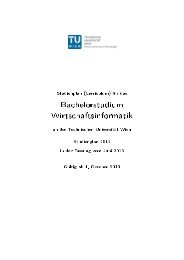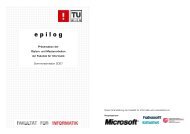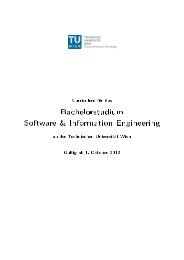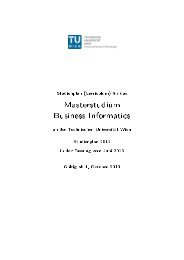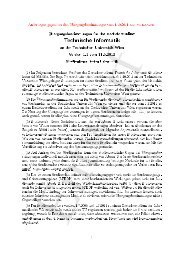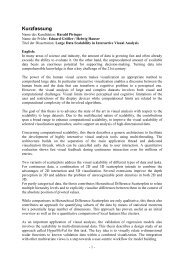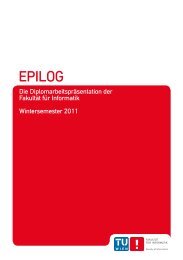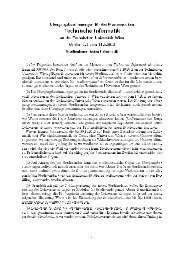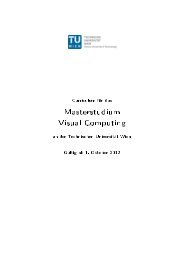Abstract-Band - Fakultät für Informatik, TU Wien - Technische ...
Abstract-Band - Fakultät für Informatik, TU Wien - Technische ...
Abstract-Band - Fakultät für Informatik, TU Wien - Technische ...
Sie wollen auch ein ePaper? Erhöhen Sie die Reichweite Ihrer Titel.
YUMPU macht aus Druck-PDFs automatisch weboptimierte ePaper, die Google liebt.
Josef Dabernig<br />
Geocluster: Server-side clustering for mapping in Drupal based on Geohash<br />
Studium: Masterstudium Software Engineering & Internet Computing<br />
BetreuerIn: O.Univ.Prof. Dr. A Min Tjoa<br />
This thesis investigates the possibility of creating a server-side clustering<br />
solution for mapping in Drupal based on Geohash. Maps visualize data in an<br />
intuitive way. Performance and readability of mapping applications decreases<br />
when displaying large amounts of data. Client-side clustering uses JavaScript to<br />
group overlapping items, but server-side clustering is needed when many<br />
items slow down processing and create network bottle necks. The main goals<br />
are: implement real-time, server-side clustering for up to 1,000,000 items<br />
within 1s and visualize clusters on an interactive map. Clustering is the task of<br />
grouping unlabeled data in an automated way. Algorithms from cluster analysis<br />
are researched in order to create an algorithm for server-side clustering with<br />
maps. The proposed algorithm uses Geohash for creating a hierarchical spatial<br />
index that supports the clustering process. Coordinates are encoded as string<br />
identifiers with a hierarchical spatial structure. The use of a Geohash-based<br />
index allows to significantly reduce the time complexity of the clustering<br />
process. Three implementations of the clustering algorithm are realized as the<br />
Geocluster module for the free and open source web framework Drupal. The<br />
first algorithm implementation based on PHP, Drupals scripting language,<br />
doesnt scale well. A second, MySQL-based clustering has been tested to scale<br />
up to 100,000 items within one second. Finally, clustering using Apache Solr<br />
scales beyond 1,000,000 items and satisfies the main research goal of the<br />
thesis. In addition to performance considerations, visualization techniques for<br />
putting clusters on a map are evaluated in an exploratory analysis. Map types<br />
as well as cluster visualization techniques are presented. The evaluation<br />
classifies the techniques for cluster visualization on maps and provides a<br />
foundation for evaluating the visual aspects of the Geocluster implementation.<br />
Peter Frühwirt<br />
Defence side reconnaissance: Preliminary surveying of an attacker's profile<br />
Studium: Masterstudium Software Engineering & Internet Computing<br />
BetreuerIn: Privatdoz. Dr. Edgar Weippl<br />
62<br />
Die steigende Komplexität von Systemen und die dadurch resultierende<br />
Vergrößerung des Angriffsvektors macht es Angreifern leichter, in Systeme<br />
einzudringen. Als Verteidiger ist man oft dazu gezwungen, die Lage vorab<br />
schnell einschätzen und eine passende Verteidigungsstrategie entwickeln zu<br />
müssen. Die bekannteste Möglichkeit zur Absicherung der eigenen Netzwerke<br />
sind Intrusion Detection Systeme (IDS). IDS erkennen Angriffe anhand von<br />
vordefinierten, statischen Signaturen oder anhand von Verhalten von<br />
Benutzern. Bestehende System haben oft das Problem, dass sie auf Grund von<br />
Signaturen relativ unflexibel sind und dadurch von Angreifern leicht umgangen<br />
werden können. Diese Arbeit befasst sich mit den theoretischen Konzepten der



